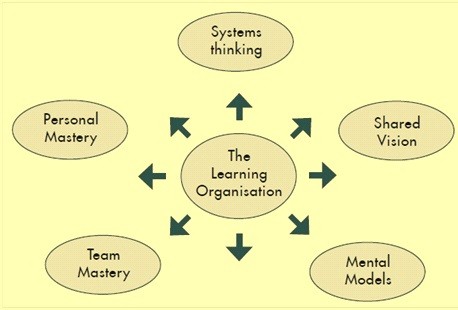As a business goes through different stages, learning new concepts, new practices and new processes becomes obligatory; each person working in the organization needs to learn to get familiar to a new thinking to achieve organizational goals. Learning Organization as a model was popularized by Peter Senge; he is an American systems scientist and a senior lecturer at the MIT Sloan School of Management, he is the founder of the Society for Organizational Learning. His book The Fifth Discipline: The art and Practice of the Learning Organization is world famous.
So what are Learning Organizations? They are organizations with an ideal learning environment, perfectly set in tune with the organization’s goals. These orga nizations create an encouraging atmosphere for employees to continually expand their capacity to create the results they truly desire, in such organizations innovative and expansive patterns of thinking are nurtured. In learning organizations collective aspiration is set free, and employees are continually learning to see the whole reality together. Learning organizations prefer continuous development and they therefore facilitate the learning and development of its members. To a great extent, learning organizations are action oriented, and are geared towards using specific indicative and evaluative methodological tools which can help to identify, promote and evaluate the quality of learning processes inside organizations
nizations create an encouraging atmosphere for employees to continually expand their capacity to create the results they truly desire, in such organizations innovative and expansive patterns of thinking are nurtured. In learning organizations collective aspiration is set free, and employees are continually learning to see the whole reality together. Learning organizations prefer continuous development and they therefore facilitate the learning and development of its members. To a great extent, learning organizations are action oriented, and are geared towards using specific indicative and evaluative methodological tools which can help to identify, promote and evaluate the quality of learning processes inside organizations
Good leadership always promotes and encourages ideal environment for learning. Peter Senge has emphasized the role of the leader in creation of learning organization. He defined five leadership roles that reshape the old-fashioned approach to being the boss. These are:
Creating shared vision: In learning organizations, the vision is usually created through interaction with the employees. When leaders have personal visions but lack the art of transferring them into others, achieving the vision becomes impossible. When everybody in the organizations shares the same values and the same vision, achieving goals becomes easier. People who do not share the same vision might not contribute as much to the organization. The effect of sharing the same vision is that employees do their tasks because they want to do so instead of they are told to do so. It changes the relationship with the company, and it turns its performances in a learning mechanism.
Cognizant is an American Multinational corporation that provides IT services, including digital, technology, consulting, and operations services. At Cognizant Technology Solutions, New Jersey, talent development is the most important activity. With more than 170,000 employees, every one of Cognizant’s employees has an individualized development plan that supports his long-term career goals in organization. For senior leadership, development comes through customized initiatives. Cognizant is a knowledge enterprise. The company’s strategy is fully dependent on their workforce talent and capabilities. The key goal of this company is talent development, it is their strategic driver.
Systems Thinking: Instead of focusing on individual issues, a system thinking which is shared helps observing the results of an entire system. Managers have to understand that every action and consequence is correlated with another. Many times it happens that managers focus on individual actions, and therefore, forget about seeing the big picture. When the bond of collective thinking is understood, it enables the leaders to see interrelationships and patterns of change in particular situations. It helps managers to determine cause and effect. Therefore, determining the policies, strategies, and structures that translate ideas into business decisions unanimously helps the organization in reaching great heights.
Tech Mahindra Limited is an Indian Multinational provider of information technology (IT), networking technology solutions and business process outsourcing (BPO) to various industry verticals and horizontals. Most of the employees in the firm say that they like to serve this organization because it provides them challenging assignments which help them to bring out the best in their creative potential and gives them an environment to constantly learn new things. This supports them to excel in their chosen field. Tech Mahindra has created effective learning processes which allow the employees for continuous improvement of the policies, strategies, and structures.
Mental Models: According to Peter Senge, the employees must identify the values of the company and what the business is all about. A correct understanding of what the organization stands for enables them to visualize where to go and how to develop further. The organization has to be flexible in accepting changes to new mental models and a new image of the company. The most successful companies are those who can learn and adapt to new models to become faster than its competitors. According to Senge, the average life of business corporations is reducing. To sustain competition and grow, organizations must continually enhance their capabilities to create new products and services. They must create products and services which can influence the consumers deeply.
At Deloitte LLP, the knowledge capital is respected the most. Deloitte strives to sustain the learning abilities of employees, the organization believes in connecting employees to one another to drive innovation and effectiveness. This ability of the organizations differentiates it from its competitors. Deloitte believes that organizations that create an environment where learning is at the heart of the corporate culture are better performing. Deloitte practices aligning the organization’s learning with the current and changing needs of the business environment. Thus, it increases employee engagement and capability to support the business strategy.
Team Mastery: To accomplish brilliant functional team dynamics, team-learning is a primarily important function. It is the discipline by which personal mastery and shared vision are brought together. It is crucial for the workforce to consider its colleagues as team members instead of rivals. If employees allow contention against each other, the work atmosphere gets contaminated and even talented people become vulnerable and withdrawn. Group politics kills talent and results become difficult to achieve. Organizations must maintain clean and open work environment where spitefulness is plugged and where honest mistakes are forgiven.
MindTree Ltd., a global IT Solutions company is recognized as a Global Most Admired Knowledge Enterprise (MAKE) winner in 2010. The MAKE Awards recognize organizations that are leaders in creating organizational intellectual capital and value through the transformation of knowledge into world-class products, services and solutions. At MindTree knowledge-driven culture is created. It believes developing knowledge workers through senior management leadership. MIndTree delivers knowledge-based products/services/solutions by maximizing enterprise intellectual capital, therefore, at MindTree employees experience conducive surrounding for collaborative knowledge sharing.
Personal Mastery: Personal mastery occurs when an individual has a clear vision of what to achieve, combined with an accurate awareness of reality. The gap between the idea and reality drives the employee to practice all necessary related activities to realize the vision. The gap between the vision and reality which a person struggles to achieve is called creative anxiety. For achieving personal mastery and the related discipline of a shared vision, looking at, and sharing the truth is a fundamental. However, when employees believe they lack the competencies to achieve their goals, a vicious circle establishes and often it becomes difficult to remove it. According to Peter Senge, organizations must train their employees’ subconscious mind because it can handle more complex problems quicker than what consciousness can. Confident employees help organizations achieve the best.
The Aerospace Corporation is a nonprofit corporation that operates a federally funded research and development centre (FFRDC) headquartered in California. The corporation provides technical guidance and advice on all aspects of space missions to military, civil, and commercial customers. It provides its employees with a wide variety of continuing education opportunities to grow professionally, from industry conferences and work-related courses, to technical and management classes. In addition to tuition reimbursement for approved work-related courses, Aerospace offers internal resources such as technical, management, and professional development classes to ensure it employees are backed with the resources needed for continuing education in their chosen field. This organization believes that a diverse workforce creates an environment in which unique ideas are developed. This organization values differing perspectives because they feel it produces superior customer solutions.
Conclusion: Peter Senge’s learning organization model reflects his belief that the way we process information, the way we see reality, is often wrong. This theory also suggests that we keep viewing the world the same way over and over again, in reality we should be responding to situations in different ways. Instead of visualizing a traditional pecking order, today’s organizations can survive when they succeeds in creating a learning organization, where people continually expand their capacity to create the results they truly desire. New and expansive patterns of thinking must be nurtured, when collective aspiration is set free achieving vision and mission becomes easier.















































